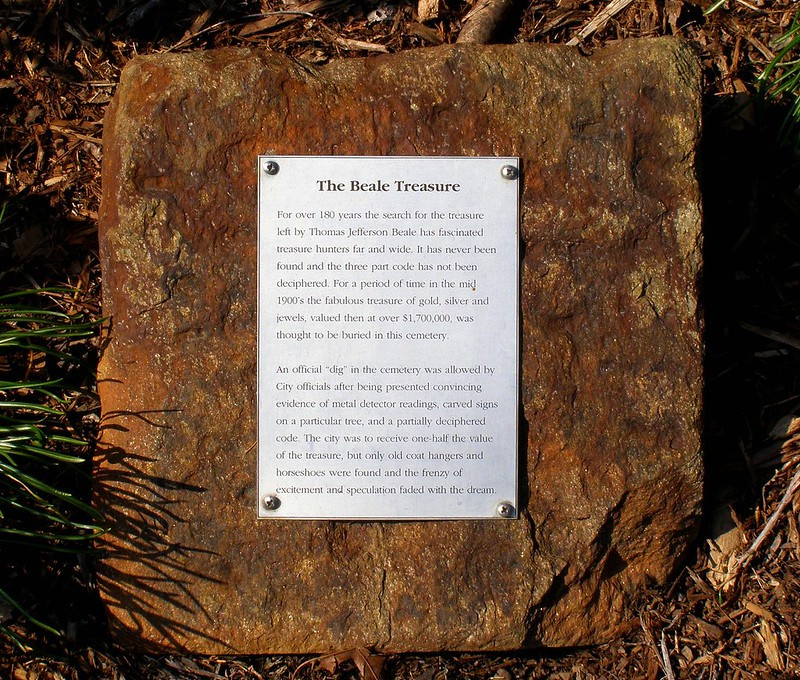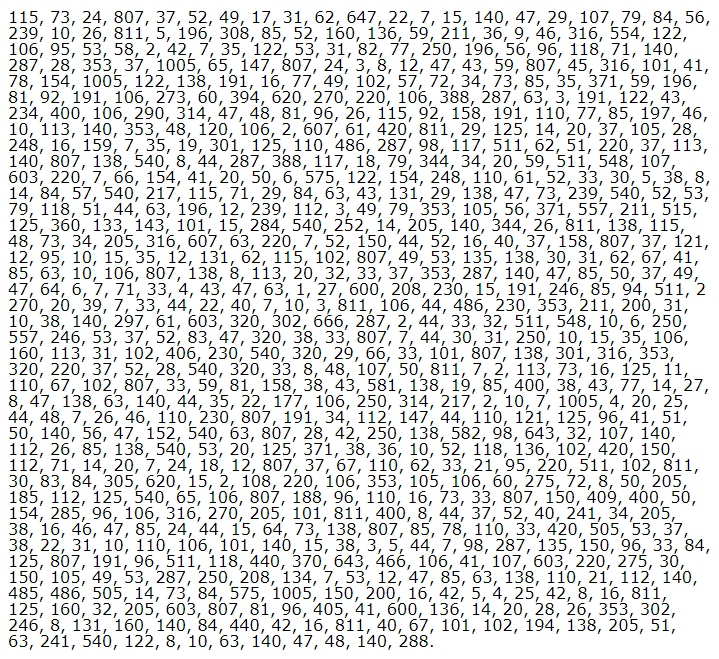
the hunt for the Beale Treasure included an excavation in the Lynchburg cemetery
Source: Virginia Hill, Old City Cemetery: Plaque About The Beale Treasure

the hunt for the Beale Treasure included an excavation in the Lynchburg cemetery
Source: Virginia Hill, Old City Cemetery: Plaque About The Beale Treasure
Many failed treasure hunts continue for gold supposedly brought to Bedford County in 1819-21. According to the tale, Thomas Jefferson Beale led a party of hunters from Bedford County to a spot 300 miles north of Santa Fe, New Mexico, near modern-day Denver. There they reportedly discovered a lode of gold and silver, and somehow mined and smelted the ore.
According to the story, Beale and his fellow hunters brought their treasure back to Buford's Tavern (now Montvale) in two wagon trains and buried it in a rock-lined underground vault. The first one in 1819 included 1,014 pounds of gold and 3,812 pounds of silver. Another wagon train in 1821 brought 1,907 pounds of gold and 1,288 pounds of silver.
Fundamental to the treasure tale is the assumption that an extraordinarily valuable hoard of gold and silver was transported across two-thirds of North America in wagons to be hidden away in Bedford County. None of the gold or silver was stolen by those transporting it, or by thieves on the 2,000 mile journey. Some silver was reportedly sold in St. Louis and jewels were bought, since those were easier to transport. If true, then keeping the shipment a secret would have been harder.
According to the story, Beale left a strongbox with a tavern keeper, went back across the Mississippi River in 1822, and never returned. A letter mailed from St. Louis told the tavern keeper to expect another letter in 1832, with a key to interpreting what was inside the strongbox.
No letter arrived in 1832. When the tavern keeper finally opened the box, he found letters to him plus three papers with numbers based on an unknown code. Text on one paper was deciphered, after code breakers realized the numbers were a substitution code based on the Declaration of Independence. The deciphered page revealed that the other two coded documents included instructions on finding where the Beale Hoard was buried in Bedford County, and the names of the 30 people who were part of the party and their next of kin.

the one decoded cipher was based on the Declaration of Independence
Source: Wikipedia, Beale ciphers
The tavern keeper passed along the strongbox and papers to someone whose name is not known today. That person gave the material to James B. Ward, and he published a pamphlet in 1885 that publicized the story of the Beale Treasure. Ward may have been the originator of a long-lasting hoax; his style of writing coincides closely with the decoded cipher. Thomas Jefferson Beale may have lived only in Ward's imagination.
Since Ward published "The Beale Papers, Containing Authentic Statements Regarding the Treasure Buried in 1819 and 1821 Near Bufords, in Bedford County, Virginia," efforts to decode the two other enciphered papers and find the treasure have provided entertainment and created multiple holes in Bedford County. Mel Fisher, who had successfully found treasure off the Florida coastline from a sunken Spanish galleon, claimed he dug a hole in the correct place - but the treasure had been moved.
Perhaps the treasure really is buried at the current site of Johnson's Orchard and Peaks of Otter Winery, but no gold supposedly hauled back from Colorado has been found in Virginia. However, the Johnsons have used the claim in their marketing:1
Today, the treasure buried six feet deep in the ground somewhere near Montvale would be worth $60-100 million. That is enough to draw people into the puzzle-solving exercise, and to visit Bedford County. Under Virginia state law, the disoverer of buried treasure - not the owner of the property where it was found - gets to keep the treasure.
Secret searches on private land have triggered local problems, separate from stimulating business at Peaks of Otter Winery. One resident commented in 1972 that landowners were firing warning shots at night:2